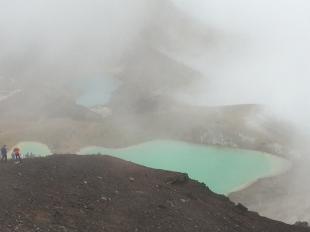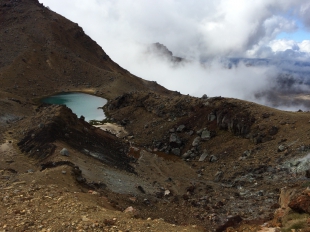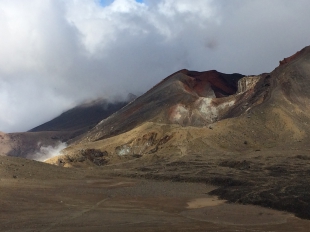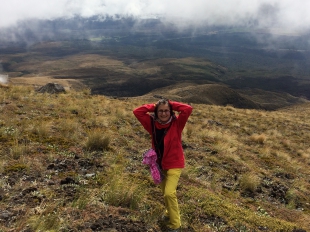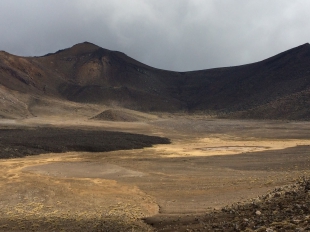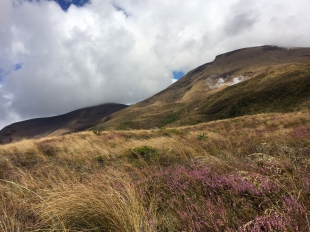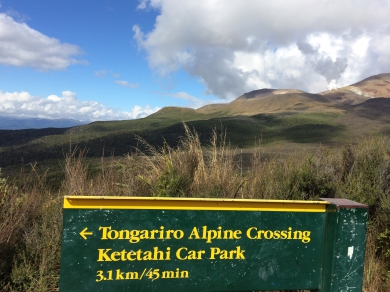 Mardi 5 avril 2016
Mardi 5 avril 2016
Nous quittons Tongariro pour la région des sources chaudes de Rotorua. Dernier coup d'oeil au volcan qui surgit des nuages au loin !
Haka - Tuesday, April 5th
We leave Tongariro for the region of the hot springs of Rotorua. Last look in the volcano which appears from clouds far off!
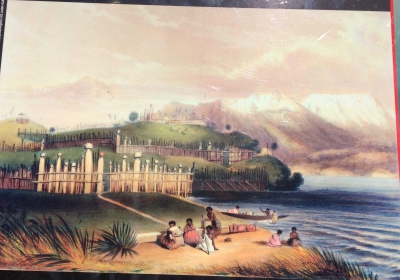 En route nous nous arrêtons au lieu où le Haka est né à Opotoka
En route nous nous arrêtons au lieu où le Haka est né à Opotoka
C’est l’histoire du guerrier Te Rauparaha poursuivi par ses ennemis ; il trouve refuge près du lac Rotoaira. Il reste caché pendant les pourparlers du chef ami Te Wharerangi (« l'homme velu ») avec les ennemis. Il répète sans arrêt les paroles de ce que deviendra le Haka
 On the way we stop us in the place where Haka was born to Opotoka.
On the way we stop us in the place where Haka was born to Opotoka.
It is the story of the warrior Te Rauparaha pursued by his enemies; he finds refuge near the lake Rotoaira. There is hidden, during the negotiations of the friendly leader Te Wharerangi (« hairy man ») with the enemies. He repeats non-stop the words of the fact what will become Haka
Te Rauparaha a composé le Ka Mate autour de 1820 comme une célébration de la vie sur la mort.
Te Rauparaha composed Ka Mate around 1820 as a celebration of the life on the death.
H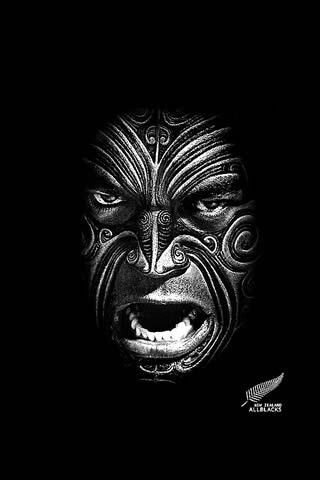 aka
aka
Ka mate, ka mate! ka ora! ka ora!
Ka mate! ka mate! ka ora! ka ora!
Tēnei te tangata pūhuruhuru
Nāna nei i tiki mai whakawhiti te rā
Ā, upane! ka upane!
Ā, upane, ka upane, whiti te ra!
Vais-je mourir, vais-je mourir ! Vais-je vivre vais-je vivre !
Vais-je mourir, vais-je mourir ! Vais-je vivre vais-je vivre !
C’est l’homme aux cheveux long
Qui est allé chercher le soleil et l’a fait briller à nouveau
Je marche vers le haut, je marche à nouveau !
 Un pas vers le haut, un autre… le soleil brille !
Un pas vers le haut, un autre… le soleil brille !
Tis death! 'tis death! (or: I may die) ’Tis life! ‘tis life! (or: I may live)
’Tis death! ‘tis death! ’Tis life! ‘tis life!
This is the hairy man
Who brought the sun and caused it to shine
A step upward, another step upward!
A step upward, another... the sun shines!
« Motuopuhi » è Est la forteresse è Is the fortress
 Autour de 1820, Te Wharerangi de Ngati Hikairo Ki Tongariro a abrité le chef fugitif Ngati Toa, Te Rauparaha. Il a été caché dans un « rua » (la fosse de stockage alimentaire) sur Motuopuhi et Ta Wharerangi a placé sa femme, Rangikoaea de Ngati Turangitukua, devant l'entrée. Les ennemis de Te Rauparaha n'ont pas pu ainsi le trouver utilisant
Autour de 1820, Te Wharerangi de Ngati Hikairo Ki Tongariro a abrité le chef fugitif Ngati Toa, Te Rauparaha. Il a été caché dans un « rua » (la fosse de stockage alimentaire) sur Motuopuhi et Ta Wharerangi a placé sa femme, Rangikoaea de Ngati Turangitukua, devant l'entrée. Les ennemis de Te Rauparaha n'ont pas pu ainsi le trouver utilisant 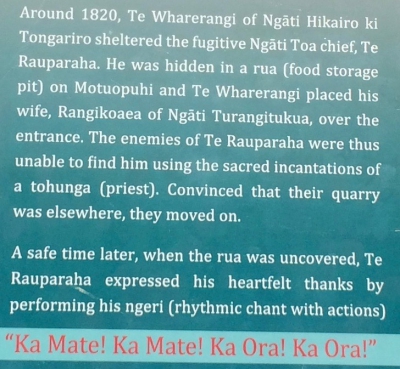 les incantations sacrées d'un « tohunga » (un prêtre). Convaincu que leur gibier était ailleurs, ils se sont remis en route.
les incantations sacrées d'un « tohunga » (un prêtre). Convaincu que leur gibier était ailleurs, ils se sont remis en route.
Around 1820, Te Wharerangi of Ngati Hikairo Ki Tongariro sheltered the fugitive Ngati Toa chief, Te Rauparaha. He was hidden in a « rua » (food storage pit) on Motuopuhi and Ta Wharerangi placed his wife, Rangikoaea of Ngati Turangitukua, over the entrance. The enemies of Te 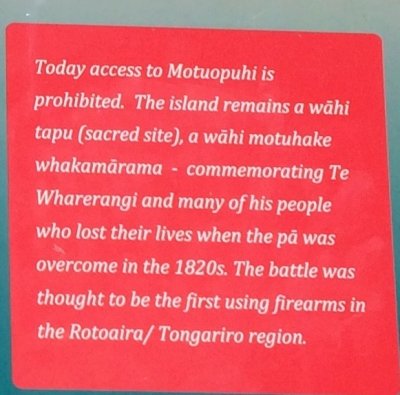 Rauparaha were thus unable to find him using the sacred incantations of a « tohunga » (priest). Convinced that their quarry was elsewhere, they moved on.
Rauparaha were thus unable to find him using the sacred incantations of a « tohunga » (priest). Convinced that their quarry was elsewhere, they moved on.
Aujourd'hui l'accès à Moruopuhi est interdit. L'île reste un « wahi tapu » (site sacré), un « wahi motuhake whakamarama » - commémorant Te Wharerangi et beaucoup de son peuple qui perdirent leur vie quand le « pa » a été surmonté dans les années 1820. La bataille a été pensée pour l’utilisation des premières armes à feu à Rotoaira et dans la région de Tongariro.
Today access to Moruopuhi is prohibited. The island remains a « wahi tapu » (sacred site), a « wahi motuhake whakamarama » - commemorating Te Wharerangi and many of his people who lost their lives when the « pa » was overcome in the 1820s. The battle was thought to be the first using firearms in the Rotoaira / Tongariro region.
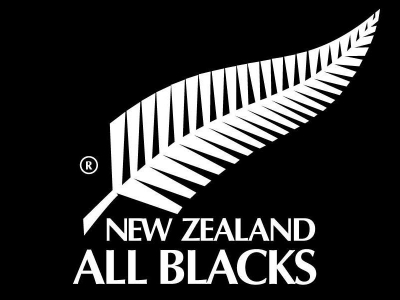 Le lien entre le Haka et les All black n’est pas récent. C’est Joseph Warbrick qui en 1888 a étroitement associé les natifs de Nouvelle Zélande et le rugby néo zélandais au Haka. Sa mystique s'est développée avec la détermination féroce, l'engagement et la compétence de haut niveau qui a été le cachet du jeu national de Nouvelle-Zélande.
Le lien entre le Haka et les All black n’est pas récent. C’est Joseph Warbrick qui en 1888 a étroitement associé les natifs de Nouvelle Zélande et le rugby néo zélandais au Haka. Sa mystique s'est développée avec la détermination féroce, l'engagement et la compétence de haut niveau qui a été le cachet du jeu national de Nouvelle-Zélande.
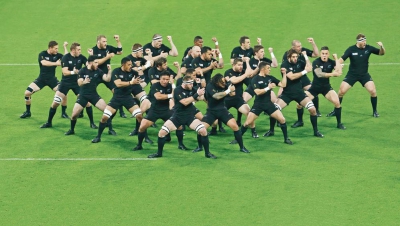 The link between Haka and All black is not recent. It is Joseph Warbrick who in 1888 closely associated the natives of New Zealand and the New Zealand rugby with Haka.
The link between Haka and All black is not recent. It is Joseph Warbrick who in 1888 closely associated the natives of New Zealand and the New Zealand rugby with Haka.
Its mystique has evolved along with the fierce determination, commitment and high level skill which has been the hallmark of New Zealand's National game.
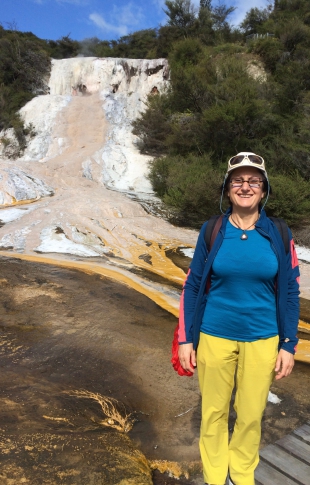 Mardi 5 avril
Mardi 5 avril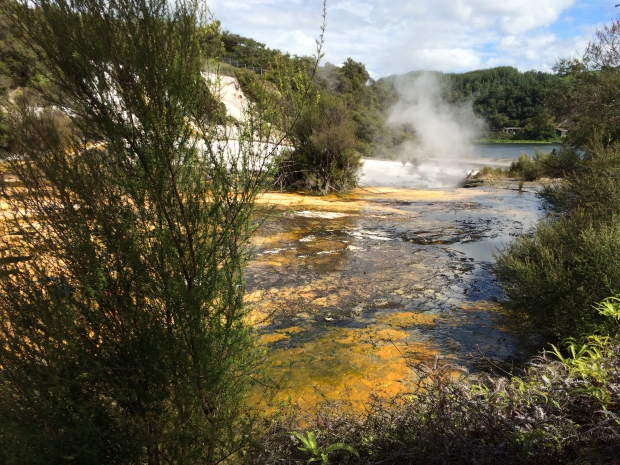

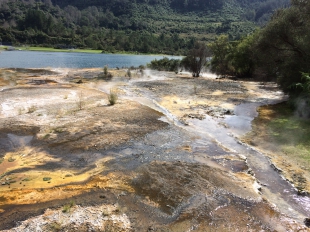
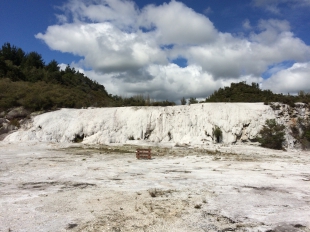
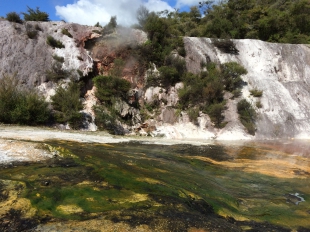
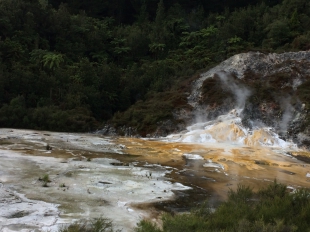

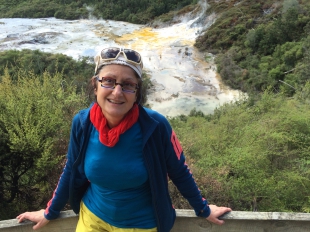
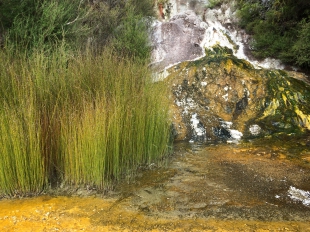
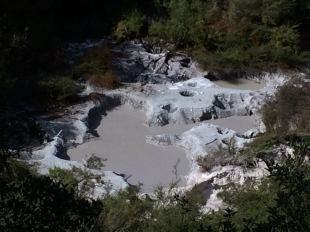
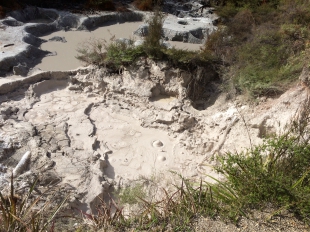
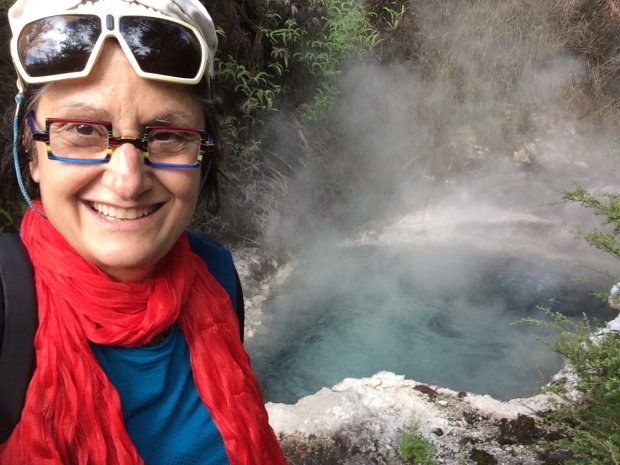
 Environ 200.000 litres d'eau plongent les neuf mètres de la grande paroi rocheuse, chaque seconde, aux Chutes de Huka - c’est assez pour remplir cinq piscines Olympiques chaque minute. Un tel flux si important d'eau crée un courant sous-marin dangereux au fond des chutes, ceci a endommagé les embarcations de beaucoup d'utilisateurs fluviaux assez imprudents pour essayer de naviguer sur les chutes.
Environ 200.000 litres d'eau plongent les neuf mètres de la grande paroi rocheuse, chaque seconde, aux Chutes de Huka - c’est assez pour remplir cinq piscines Olympiques chaque minute. Un tel flux si important d'eau crée un courant sous-marin dangereux au fond des chutes, ceci a endommagé les embarcations de beaucoup d'utilisateurs fluviaux assez imprudents pour essayer de naviguer sur les chutes.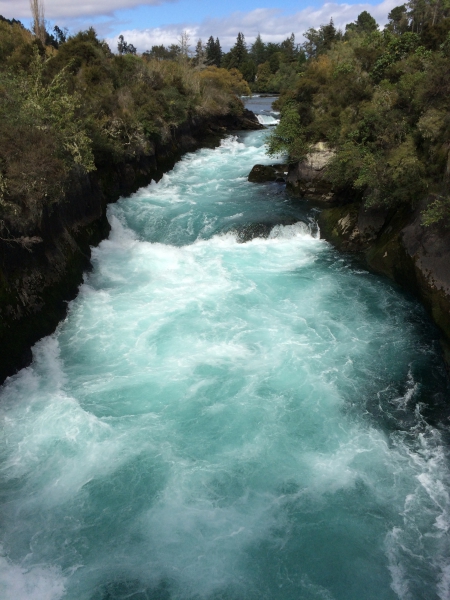 En amont des chutes, le Waikato (plus long fleuve de Nouvelle-Zélande, 425 kilomètres de sa source à la mer, au sud d'Auckland) est clair et réfléchissant. Après la plongée sur les chutes, il prend les masses des bulles d'air dégringolantes qui créent des couleurs à couper le souffle et prend le nom de chutes, après le mot maori qui est "la mousse".
En amont des chutes, le Waikato (plus long fleuve de Nouvelle-Zélande, 425 kilomètres de sa source à la mer, au sud d'Auckland) est clair et réfléchissant. Après la plongée sur les chutes, il prend les masses des bulles d'air dégringolantes qui créent des couleurs à couper le souffle et prend le nom de chutes, après le mot maori qui est "la mousse". être trouvée dans le Lac Taupo.
être trouvée dans le Lac Taupo. its 425-kilometre journey to the sea south of Auckland) is clear and reflective. After plunging over the falls it picks up masses of tumbling air bubbles which create breathtaking colours and give the falls name, after the maori word for « foam ».
its 425-kilometre journey to the sea south of Auckland) is clear and reflective. After plunging over the falls it picks up masses of tumbling air bubbles which create breathtaking colours and give the falls name, after the maori word for « foam ». Mardi 5 avril 2016
Mardi 5 avril 2016  En route nous nous arrêtons au lieu où le Haka est né à Opotoka
En route nous nous arrêtons au lieu où le Haka est né à Opotoka On the way we stop us in the place where Haka was born to Opotoka.
On the way we stop us in the place where Haka was born to Opotoka. aka
aka Un pas vers le haut, un autre… le soleil brille !
Un pas vers le haut, un autre… le soleil brille ! Autour de 1820, Te Wharerangi de Ngati Hikairo Ki Tongariro a abrité le chef fugitif Ngati Toa, Te Rauparaha. Il a été caché dans un « rua » (la fosse de stockage alimentaire) sur Motuopuhi et Ta Wharerangi a placé sa femme, Rangikoaea de Ngati Turangitukua, devant l'entrée. Les ennemis de Te Rauparaha n'ont pas pu ainsi le trouver utilisant
Autour de 1820, Te Wharerangi de Ngati Hikairo Ki Tongariro a abrité le chef fugitif Ngati Toa, Te Rauparaha. Il a été caché dans un « rua » (la fosse de stockage alimentaire) sur Motuopuhi et Ta Wharerangi a placé sa femme, Rangikoaea de Ngati Turangitukua, devant l'entrée. Les ennemis de Te Rauparaha n'ont pas pu ainsi le trouver utilisant  les incantations sacrées d'un « tohunga » (un prêtre). Convaincu que leur gibier était ailleurs, ils se sont remis en route.
les incantations sacrées d'un « tohunga » (un prêtre). Convaincu que leur gibier était ailleurs, ils se sont remis en route. Rauparaha were thus unable to find him using the sacred incantations of a « tohunga » (priest). Convinced that their quarry was elsewhere, they moved on.
Rauparaha were thus unable to find him using the sacred incantations of a « tohunga » (priest). Convinced that their quarry was elsewhere, they moved on. Le lien entre le Haka et les All black
Le lien entre le Haka et les All black The link between Haka and All black
The link between Haka and All black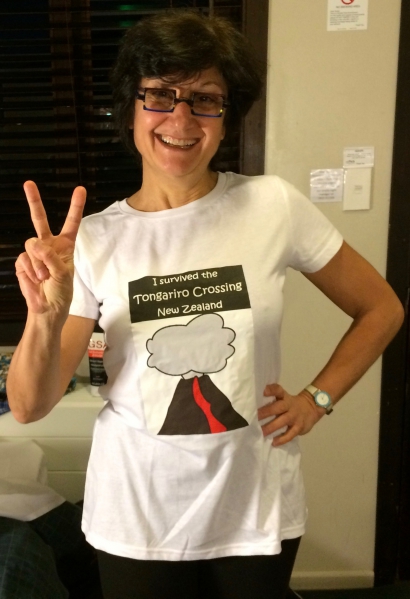 Lundi 4 avril
Lundi 4 avril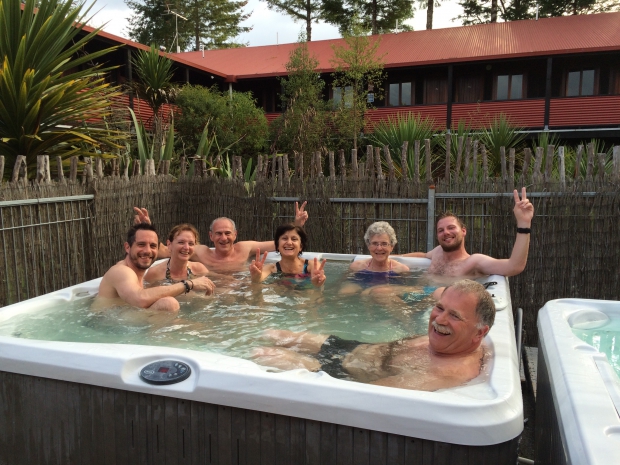
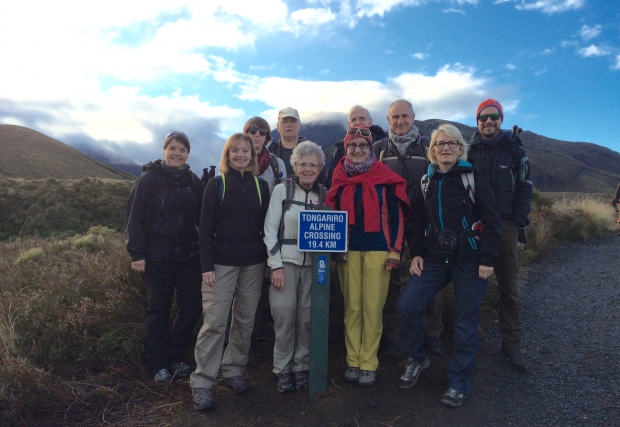
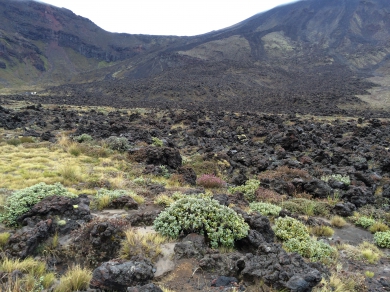

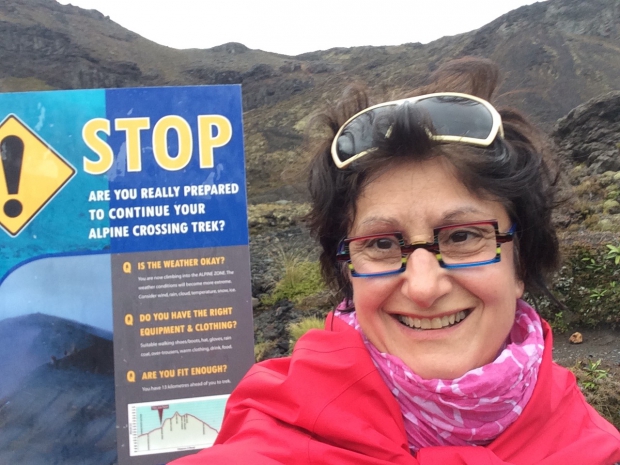
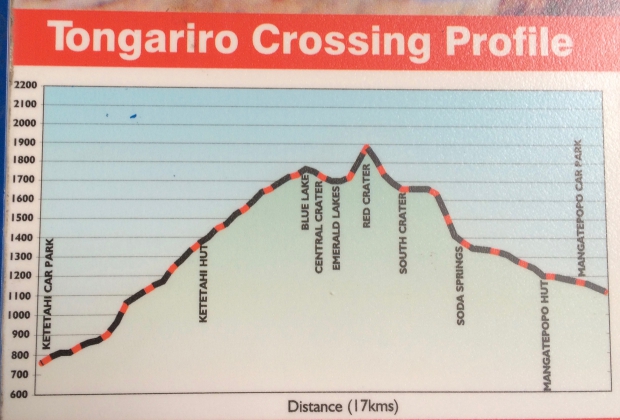
 Bien sûr, comme tous les bons marcheurs nous partons tôt... 7 h !
Bien sûr, comme tous les bons marcheurs nous partons tôt... 7 h !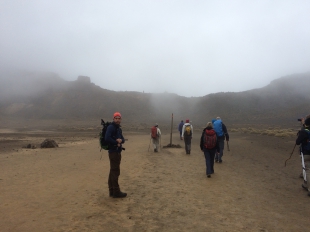
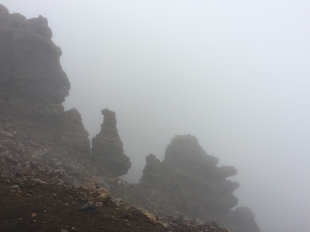
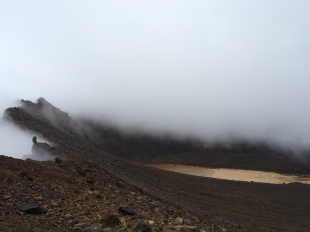
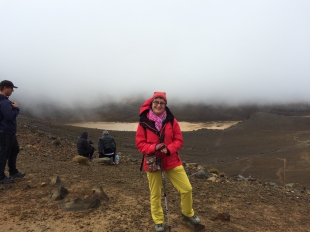
 Ça grimpe raide au démarrage et la descente n’en finit pas… Mais qu’est-ce que c’est beau ! ça vaut la peine…
Ça grimpe raide au démarrage et la descente n’en finit pas… Mais qu’est-ce que c’est beau ! ça vaut la peine…